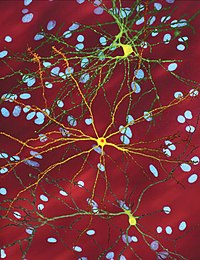
Photo from wikipedia
BACKGROUND Iron deposition within the substantia nigra (SN) has been postulated to play a vital role in Parkinson's disease (PD). The aim of this study was to explore the inherent… Click to show full abstract
BACKGROUND Iron deposition within the substantia nigra (SN) has been postulated to play a vital role in Parkinson's disease (PD). The aim of this study was to explore the inherent link of PD patients between their substantia nigra iron accumulation and clinical status using quantitative susceptibility mapping (QSM) which is now considered to be the only quantitative imaging technique of brain iron deposition. METHODS 44 PD patients and 31 age- and gender-matched healthy controls underwent quantitative susceptibility mapping (QSM) were recruited in this study. We firstly divided the patients into mild symptom severity (MSP) and advanced symptom severity (ASP) groups concerning their disease stage, aiming to illuminate the relationship between iron deposition in SN of PD and disease progression. Then, we classified the patients with Parkinson's disease into three subgroups: tremor-dominant PD (TD), akinetic/rigidity-dominant PD (AR), mixed-PD (M) according to their dominant motor symptoms in order to investigate whether there are any effects of SN iron accumulation to different subtypes of PD patients. RESULTS Compared to healthy controls, patients with PD have increased QSM magnetic values in the substantia nigra (138.039±37.320 vs 179.553±65.715; P=0.001). More prominent statistically significance of the difference of SN iron deposition between healthy controls (HC) and advanced symptom severity (ASP) subgroup was displayed (138.039±37.320 vs 232.827±92.040; P<0.001). Besides, among the three clinical phenotypes both TD and AR subgroup showed significant difference compared with healthy controls concerning the QSM values (138.039±37.320 vs 185.864±99.851; P=0.013; 188.148±52.958 vs 138.039±37.320; P=0.001). Furthermore, the iron content in the SN of PD patients was significantly correlated with the Hoehn-Yahr stage, the Unified Parkinson's Disease Rating Scale (UPDRS), Montgomery Asberg Depression Rating Scale (MADRS) and Hamilton Anxiety Scale (HAMA) scores (r=0.417, P=0.005; r=0.300, P=0.048; r=0.540, P<0.001; r=0.553, P<0.001). In MSP the significantly correlation was displayed only in MADRS, HAMA scores (r=0.429, P=0.013; r=0.492, P=0.004), when disease progressed into advanced severity stage all these clinical measures (Hoehn-Yahr stage, UPDRS-3, UPDRS, HAMA, and MADRS scores) we had recruited into this study shown prominent correlation to SN iron content (r=0.650, P=0.030; r=0.709, P=0.015; r=0.708, P=0.015; r=0.758, P=0.007; r=0.683, P=0.020). In the three phenotypes the correlation between iron content and MADRS, HAMA scores (r=0.686, P=0.002; r=0.633, P=0.006) was found in AR subgroups exclusively. CONCLUSIONS Patients with PD exhibited significantly higher magnetic susceptibility values, especially in those who are in advanced disease severity stage, which confirmed that iron accumulation in the SN is in line with Parkinson's disease progression. Furthermore, we testified that there are actually some inherent effects of substantia nigra iron deposition to the clinical symptoms of Parkinson's disease. Moreover, it seems that akinetic/rigidity-dominant PD subgroup was affected most by SN iron accumulation.
Journal Title: Journal of the Neurological Sciences
Year Published: 2018
Link to full text (if available)
Share on Social Media: Sign Up to like & get
recommendations!